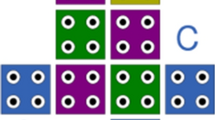Abstract
Quantum-dot cellular automata (QCAs) are one of the most significant state-of-the-art technologies that have exhibited the potential to replace the complementary metal oxide semiconductor. QCA offers a variety of benefits over its conventional counterpart, including size, latency, and energy consumption. Meanwhile, multiplexers are crucial to the design of arithmetic and logic circuits, and NOT-AND (NAND) gates are universal gates that allow the design of any circuit. In this paper, we propose a new multiplexer based on three NAND gates in QCA. De Morgan's law is used to derive new equations and to design multiplexers using only NAND logics. The proposed circuit is designed and verified not only to minimize time and space complexity but also to minimize energy loss. Finally, we design an arithmetic circuit that is capable of performing various operations using the proposed multiplexer.















Similar content being viewed by others
References
Roy A, Chatterjee D, Pal S (2012) Synthesis of quantum multiplexer circuits. Int J Sci 9:67–74
Jeon JC (2016) Low hardware complexity QCA decoding architecture using inverter chain. Int J Control Autom 9:347–358
Rakotonirainy A, Obst P, Loke SW (2012) Socially aware computing constructs. Int J Soc Humanist Comput 1:375–395
Kim KW, Jeon JC (2015) A semi-systolic Montgomery multiplier over GF (2m). IEICE Electron Express 12:1–6
Rahimi E, Nejad SM (2012) Scalable minority gate: a new device in two-dot molecular quantum-dot cellular automata. IET Micro Nano Lett 7:802–805
Kummamuru RK, Orlov AO, Ramasubramaniam R, Lent CS, Bernstein GH, Snider GL (2003) Operation of a quantum-dot cellular automata (QCA) shift register and analysis of errors. IEEE Trans Electron Devices 50:1906–1913
Jeon JC (2015) Extendable quantum-dot cellular automata decoding architecture using 5-input majority gate. Int J Control Autom 8:107–118
Orlov AO, Amlani I, Bernstein GH, Lent CS, Snider GL (1997) Realization of a functional cell for quantum-dot cellular automata. Science 277:928–930
Thapliyal H, Ranganathan N (2010) Reversible logic-based concurrently testable latches for molecular QCA. IEEE Trans Nanotechnol 9:62–69
Erniyazov S, Jeon JC (2019) Carry save adder and carry look ahead adder using inverter chain based coplanar QCA full adder for low energy dissipation. Microelectron Eng 211:37–43
Jeon JC (2019) Low complexity QCA universal shift register design using multiplexer and D flip-flop based on electronic correlations. J Supercomput. https://doi.org/10.1007/s11227-019-02962-y
Rajmohan V, Renganathan V, Rajomohan M (2011) A novel reversible design of unified single digit BCD adder–subtractor. Int J Comput Theory Eng 3:697–700
Kim K, Wu K, Karri R (2007) The robust adder designs using composable QCA building blocks. IEEE Trans Comput 26:176–183
Tougaw PD, Lent CS (1994) Logical devices implemented using quantum cellular automata. J Appl Phys 75:1818–1825
Lee JS, Jeon JC (2016) Design of low hardware complexity multiplexer using NAND gates on quantum-dot cellular automata. Int J Multimed Ubiquitous Eng 11:307–318
Udhayakumar C, Niranjana MI, Gowrimanohari R, Kumar EA (2014) Design of various logic gates and multiplexer in QCA. Int J Adv Eng Res Technol 2:265–269
Lee JS, Jeon JC (2016) NAND gate based QCA 2-to-1 line multiplexer. Asia Pac Proc Appl Sci Eng Better Hum Life 6:45–48
Safoev N, Jeon JC (2016) Low area complexity demultiplexer based on multilayer quantum-dot cellular automata. Int J Control Autom 9:165–178
Mardiris VA, Karafyllidis IG (2010) Design and simulation of modular 2 to 1 quantum-dot cellular automata (QCA) multiplexers. Int J Circuit Theory Appl 38:771–785
Mukhopadhyay D, Dinda S, Dutta P (2011) Designing and implementation of quantum cellular automata 2:1 multiplexer circuit. Int J Comput Appl Technol 25:21–24
Hashemi S, Navi K (2012) New robust QCA D flip flop and memory structures. Microelectron J 43:929–940
Roohi A, Khademolhosseini H, Sayedsalehi S, Navi K (2011) A novel architecture for quantum-dot cellular automata multiplexer. Int J Comput Sci 8:55–60
Sen B, Goswami M, Mazumdar S, Sikdar BK (2015) Towards modular design of reliable quantum-dot cellular automata logic circuit using multiplexers. Comput Electr Eng 45:42–54
Walus K, Dysart TJ, Jullien GA, Budiman RA (2004) QCADesigner: a rapid design and simulation tool for quantum-dot cellular automata. IEEE Trans Nanotechnol 3:26–31
Safoev N, Jeon JC (2020) Design of high-performance QCA incrementer/decrementer circuit based on adder/subtractor methodology. Microprocess Microsyst 72:102927
Safoev N, Jeon JC (2020) A novel controllable inverter and adder/subtractor in quantum-dot cellular automata using cell interaction based XOR gate. Microelectron Eng 222:111197
Makanda K, Jeon JC (2013) Improvement of quantum-dot cellular automata decoder using inverter chain. Adv Sci Technol Lett 29:227–229
You YW, Jeon JC (2017) Two dimensional QCA XOR logic using NNI gate. Int J Control Autom 10:217–226
Srivastava S, Asthana A, Bhanja S, Sarkar S (2011) QCAPro-an error power estimation tool for QCA circuit design. In: IEEE International Symposium Circuits System, pp 2377–2380
Acknowledgements
This work was supported by the National Research Foundation of Korea (NRF) grant funded by the Korea government (MSIP) (No. NRF2017R1D1A3B03034346).
Author information
Authors and Affiliations
Corresponding author
Additional information
Publisher's Note
Springer Nature remains neutral with regard to jurisdictional claims in published maps and institutional affiliations.
Rights and permissions
About this article
Cite this article
Jeon, JC. Designing nanotechnology QCA–multiplexer using majority function-based NAND for quantum computing. J Supercomput 77, 1562–1578 (2021). https://doi.org/10.1007/s11227-020-03341-8
Published:
Issue Date:
DOI: https://doi.org/10.1007/s11227-020-03341-8




